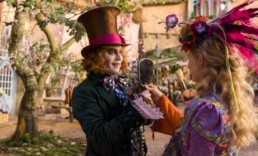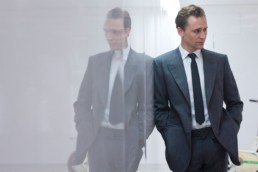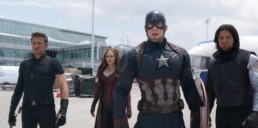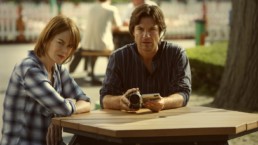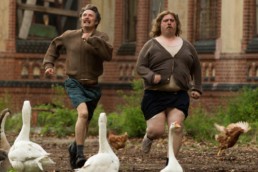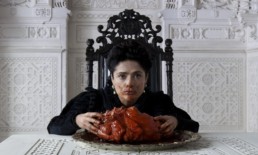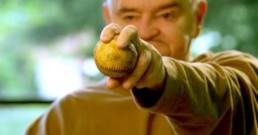Lighter in Tone, 'Alice Through the Looking Glass' is More Disheveled Than Its Predecessor
"Alice in Wonderland" is one of the world’s great “modern” fairy tales. Okay, well, Lewis Carroll’s original novel is nearly 150 years old, so to call it modern would be hardly accurate. But looking at this decade’s affinity for modernizing the classic fables of lore and dressing them up with lots of CGI, dashing them with a cup of angst and coating them in 3D to boost those box office numbers, no movie is more greatly responsible than Tim Burton’s 2010 blockbuster adaptation of "Alice In Wonderland." Six years and nearly a dozen remakes later, "Alice Through the Looking Glass" falls into theaters.
"Alice Through The Looking Glass" is perhaps a misleading title as the story only begins with Alice (Mia Wasikowska) finding her back to Wonderland through a mirror at a luxurious party. Once there, she finds the Mad Hatter (Johnny Depp) literally withering away in defeat from his family's disappearance many years ago. After finding a paper hat that he thought his father tossed away, he is convinced they are still alive, and thus, Alice sets out to change history by meeting Time (Sacha Baron Cohen) and see if she can keep the Hatter alive.
The key themes of "Alice Through the Looking Glass" is actually time and history. It is a lofty idea that the film explores with a very adventurous spirit. It's a lighter ride than Tim Burton's characteristically dark original (is that cool to call it the original in this case?). Though its tone may be lighter, however, this entry is a whole lot more complicated. The story unravels as an incoherent mess, attempting to merge upwards of three separate storylines into a cohesive narrative. In the beginning, Alice is frustrated with her place as a woman in high society, instead wanting to be a ship's captain. Then the story becomes the Mad Hatter's tale. Then Time's struggle takes over, only to be thwarted by an origin story about the Queen of Hearts. It's a movie that is both a sequel and a prequel and, really, neither feels very urgent and necessary.
The film then becomes a feat of "set-piece engineering" so to speak, the same kind of storytelling expected on a theme park ride; the narrative threads all loosely connect, but they are secondary to "oh hey, this looks cool!" wonders of production design. And, much like the 2010 original, the design is rather zany in a wonderful way. Rich colors and textures that Lewis Carroll himself would be proud of. Look closely though and the gimmickry shows very clearly, especially in 3D. Sometimes, the effects wizardry is outstanding (i.e. any of Alice's wonderland friends), but there are sequences where the CGI is embarrassing in certain scenes, especially a laughable time-mobile chase between Alice and Time that is reminiscent of a mediocre early 2000's sci-fi television program. In this way, the erratic visual quality of Wonderland becomes rather distracting.
Mia Wasikowska and Sacha Baron Cohen both do their very best and are as magnetic as usual. They cannot save the ship, unfortunately. The film represents a rare misstep for Disney– a studio that has had a rather impressive year for reinventing classic stories with not only technical wizardry but true narrative heft. Unfortunately, this seems to be their weakest film in nearly a decade.
"Alice Through The Looking Glass" is rated PG for fantasy action/peril and some language. Now playing in theaters everywhere.
'Dheepan' Is an Enlightening, Quiet Portrait of Tamil Refugees
With the 69th annual Cannes Film Festival underway, it is a very exciting time for international film. The first glimpses of possibly end-of-the-year and Oscar favorites are keeping the press abuzz. In some ways, it is only fitting that the 2015 winner of the coveted Palme d’Or finally reaches American cinemas."Dheepan", from director Jacques Audiard, has been making its international festival rounds to much fanfare and glowing press, however, it’s North American release comes quietly.
The film follows a soldier who fought as a Tamil in the Sri Lankan Civil War. After the conflict, he is moved to a refugee camp following his defeat. Seeking a way out of the country, he assumes the name Dheepan by using the passport of a fallen man and poses a woman and child whom he does not know as his family. The trio land in a housing project in suburban France, where Dheepan becomes the caretaker, only to find that the project is the base for a host of organized thugs.
The film's central story is one that is particularly enlightening considering the parallels to the current refugee crisis in Europe. The film's deliberate sense of realism and grit heightens not only it’s emotional impact but also provides a greater context for those far removed from the current international strife. What is perhaps most effective, though, is the film’s tendency to focus on greater themes of foreign adjustment, and not just in its cultural relevancy.
Unfortunately, despite fantastic lead performances from Antonythasan Jesuthasan, Kalieaswari Srinivasan and Claudine Vinasithamby, the film’s plotting falters as it goes forth. The film is a rather quiet portrait that slowly becomes a violent thriller in the final act. This is not to say it is not a thrilling switch. Without spoiling too much of the plot, the dissonance between the quiet, affecting first two acts and the loud, conflict zone that the third act introduces is jarring, despite its thematic purpose.
And thus, "Dheepan" is a film that, oddly enough, a lot of action films can learn from. It molds its characters carefully, with a sense of verité. Dheepan and his family are not too far removed from modern society’s anxieties - they feel authentic, not only as refugees but as people. While this gives the film’s rugged edge some heft, "Dheepan" does unfortunately drag. If it stayed away from bombast, it could be quite the motion picture. It is still a relevant narrative worthy of its place in cinemas.
"Dheepan" is rated R for violence, language, and brief sexuality/nudity. Now playing at Laemmle's Royal Theatre.
'High-Rise' Review: Elevated With a Surrealist Style
There is an exciting lot of new genre filmmakers bubbling in the independent world. Englishman Ben Wheatley may be one of the most impressive, building a near-flawless little filmography in the past half decade of movies that shake up characteristics of horror, crime, comedy and drama into a nasty, but highly original little brew of the dark comedic thriller. Adapted from J.G. Ballard’s 1975 novel, "High-Rise" finds him at his best with a very exciting team, and the film itself is perhaps is his most fascinating visually, but storywise feels rather monotonous.
"High-Rise" reintroduces a 70s retro-futurist view of suburban England. Moving into “the high-rise” is its newest resident, physiologist Dr. Robert Laing (Tom Hiddleston). Very quickly, he becomes caught in the middle of the building’s rigid system of class division and the differences between the higher floors and lower floors (the size of their parties, the quality of their utilities, etc.). He acts as a quiet friend and ally to residents throughout the tower. There is the gorgeous, mysterious Charlotte Melville (Sienna Miller) and her young son who live a floor above him, the pregnant Helen (Elisabeth Moss) and her erratic husband Wilder (Luke Evans) - whose knack for causing a ruckus leads to the eventual downfall (not literal) of the tower - live several floors below, and then on the tip-top is The Architect (Jeremy Irons), who has designed the building for social change.
On paper, this class system seems easy enough to understand. However, Wheatley’s direction and script - co-written by his collaborator Amy Jump - do little to really make the differences apparent beyond the fact that residents live on different floors. Henceforth, the entirety of the takedown of the society feels terribly baffling and unexciting. While the themes of class struggle are particularly relevant in our current day and age (see 2013’s "Snowpiercer" for an equally bonkers film, but a superior story), "High-Rise" finds Jump and Wheatley much fonder of style over any substance, adding a full kettle of surrealist cinema to a single cup of political allegory.
But, to shrug it off as an exercise in socioeconomic absurdism is not a worthy excuse, there is, if only, an escalating sense of surrealist anarchy and chaos that arises from the vague grievances of the tower’s residents and continuing power outages. Somewhere in the middle of the panic is the cool and collected Dr. Laing, somehow the story’s connective tissue, but there is very little else to connect the intersecting story elements except his presence, which diminishes to a supporting role as the film trods onward. The ensuing orgy of continuous sex and violence that occurs in the lengthy final act feels frustratingly inconsequential as well.
The actors do their best, though. In fact, there is no bad performances in the lot; they do the absolute best they can with what they are given. Laurie Rose’s cinematography is another specific highlight; production designer Mark Tildesley’s rich color palette and sense of composition may very well be the elements that hold your attention for two otherwise dull hours. Composer Clint Mansell is in top form as well with his orchestrations working close in tandem with a fantastic, diverse 70s soundtrack. It was exciting to see a wildly exciting young filmmaker as Wheatley make the leap to something as big a "High-Rise", but he might be best sticking to his own material from now on. It is quite unfortunate, though, that such wonderful and unique aesthetics lead to such a monotonous motion picture.
"High-Rise" is rated R for violence, disturbing images, strong sexual content/graphic nudity, language and some drug use. Now Playing.
'Captain America: Civil War' Is on the Way to Save the American Blockbuster
A little over a year ago, the earth quaked when storied director Paul Thomas Anderson defended superhero movies. “And what’s wrong with superhero movies, you know? I don’t know. You’re talking to someone that enjoys watching those films,” Anderson said in an interview. “People need to get a life if they’re having that discussion. Those movies get a bad rap.” For a director like Anderson, both a towering cult figure in American independent cinema and a widely-celebrated, Oscar-nominated auteur, to say something like this seems like blasphemy to legions of cinephiles who stick up their noses at the blockbuster genre. Whichever way the film blows, the costumed crusaders are here to stay in our multiplexes for a very long while, so audiences better suit up and get used to it.
Captain America: Civil War is the latest juggernaut in the legion of superhero movies and it’s a doozy. It’s a superhero movie that proves exactly how much a superhero film can actually accomplish with the right team behind the camera. It’s a great freighter ship, yet it moves with the nimble agility of a jackrabbit. It’s popcorn-stuffing action, yet it’s a relevant fable on American politics and our politician's refusal to compromise for the greater good. It’s inconsequential, only a chapter in something much larger and grander, but it’s a spectacle to behold, a tentpole worth rooting for.
The third installment in the Captain America series - or the 13th movie in the Marvel Cinematic Universe (MCU, as the kids call it) - leads right where last year’s Avengers: Age of Ultron left off. After the successful, but destructive missions in Sokovia (Age of Ultron) and Lagos (the opening scene in Civil War), the United Nations has decided to put a new set of laws called the Sokovia Accords to keep the Avengers in check under global government eye. The agreement creates a rift in the team with Captain America aka Steve Rogers (Chris Evans) not trusting the government’s judgement over his own and Iron Man aka Tony Stark (Robert Downey, Jr.) in support of the oversight as he feels a sense of responsibility for the mess in Sokovia and wants to prevent from happening again. After a bombing at the UN, the group becomes further divided as their motivations to find who carried it out become disparate. Eventually, the Avengers find themselves fighting each other rather than those they should band together to stop.
The superhero v. superhero dilemma may be trendy right now with the disappointing mouthful Batman v. Superman: Dawn of Justice only a wee couple months ago, but Civil War benefits from its audiences great knowledge and understanding of these characters from a baker’s dozen of films before. The feeling of watching Civil War is similar to the ecstasy of two recent blockbusters. One is, of course, the original Avengers film in 2012, a how-is-this-going-to-work stunt of blockbuster filmmaking that gave each of its characters their own spotlight while relishing in well-choreographed superhero team-up action. The second is a bit unorthodox. Harry Potter and the Deathly Hallows, Pt. 2. Why? Because like that final film in the wizarding saga, Civil War is a film with an ensemble of characters that audiences have come to know rather well over an entire franchise - their powers, their quirks, their ticks, etc. And seeing them in genuine conflict, making genuinely difficult and, a major key here, interesting decisions proves to be an emotional effective practice, even for a superhero movie.
Top that off with some of the best action to ever be shot in recent movie history as well. Remarkably, the directorial team of Anthony and Joe Russo find a way to visually keep the audience in the battle with a keen sense of geography and character communication. The script is quick on its feet as well, as Marvel is beginning to leave much of the corny, fan-service humor behind that littered a lot of its earlier installments. Or maybe that’s still there and that “fan service” isn’t as annoying anymore because, at this point, we are all slowly becoming fans. Like Paul Thomas Anderson said: “What’s wrong with superhero movies?” If Civil War is the dawn of what else Marvel is bringing, things should only get better, not only for superhero movies. Captain America is on his way to saving the American blockbuster.
Captain America: Civil War is rated PG-13. Now playing in theaters everywhere.
'The Family Fang' Cements Jason Bateman's Talent Behind the Camera
It’s been a swift twelve years since Little Miss Sunshine charmed the world with its centerpiece family of misfits and misanthropes. Since their road trip has ended, the dysfunctional family has been a centerpiece of the independent film world. With his second directorial effort, Jason Bateman introduces one of the wackier families to grace the screen in the adaptation of the best-selling novel, The Family Fang.
The titular Family Fang are an oddball unit of performance artists, including parents Caleb (Christopher Walken) and Camille Fang (Maryann Plunkett). Their two children, Annie (Nicole Kidman) and Baxter (Jason Bateman) are the centerpieces of their parents' real-world-set performances on unsuspecting public crowds unaware of their artistic intentions. For example, the opening scene (seen in flashback) features their young son holding up a bank teller with a real gun until she hands over the lollipops she keeps at her desk. Then Caleb Fang, dressed as a cop, runs over to tackle his son "the robber", only to have him “shoot” a nearby woman (aka Camille Fang). It’s all quite bizarre, but it’s part of a greater ruse for the Fang’s art; something Caleb Fang is consistently, if not annoyingly, reminding us.
Flash forward thirty years - Annie (Nicole Kidman) is a successful, if not troubled, actress in Los Angeles and Baxter (Jason Bateman) is a likewise successful, if not troubled, writer. After getting shot with a potato gun while writing an article on the subculture, all four Fang’s reunite at their family home in upstate New York. Soon after Caleb and Camille go ‘missing’ in a bloody roadside crime, Annie and Baxter believe that this is the Fang’s final performance, and they go out in search of their missing parents.
The Family Fang is a wildly original tale. Its density is rather remarkable for what, on the surface, looks like a standard indie dysfunctional family comedy. It is a wonderful look at the definition of art and what it can be, as well as the process of creating it. The film is able to bring more of these ideas across through it’s clever, if not necessary, use of flashback and deftly-woven faux-documentary footage that makes the Fang’s bizarre, artistic nature tangible. The heart of the film lies in its exploration of authenticity, which, as mentioned, can be a little ham-fisted at times, however, there are some revelatory ideas that spring from Annie and Baxter’s pursuit of the truth about their parents. In the end, however, the plot and its weighty ideas get very muddy, leaving the climax to be rather dissatisfying.
What could be most impressive is Jason Bateman’s direction. After his bonkers debut feature, Bad Words, Bateman explores the same themes of struggling to shake an unorthodox childhood. While no masterpiece, The Family Fang cements his talent behind the camera. His keen comedic sensibility is smooth with emotional gravitas. As Baxter, he is also endearing, playing his usual middle-aged downbeat character, but this time with remarkable honesty. He also rounds up a collective of wonderful performances from always great performers Kidman, Walken, and Plunkett for an authentic family unit.
And see, The Family Fang could have drifted down the path of eccentricity for eccentricity’s sake, but there is a weight to that theme of authenticity. The Family Fang finds something true, new and real from the dysfunction that is seen all too often.
The Family Fang is rated R for some language. In theaters (Laemmle Theaters in Santa Monica, Pasadena, North Hollywood and Sundance Sunset Cinemas) today.
'Men & Chicken' Is Absurdist Comedy About the Human Condition
The "men" in Men & Chicken are two brothers, Elias (Mads Mikkelsen) and Gabriel (David Dencik) who learn from a VHS recording their deceased father left for them that they were adopted from a noted geneticist. Setting out to a small (fictional) isle off the coast of Denmark, the two find his residence to be a sanitarium nearly in ruins, but still inhabited by three brothers they had never met - each rather loony and odd-looking - and hundreds of strange chickens. Curiously, however, Elias and Gabriel are not able to meet their father because he is locked up with an infection, thus they begin to dig for more clues in the mansion.
And, get this, it's even more bonkers than it sounds. Director Anders Thomas Jensen really hones in the quirkiness (with a dash of surrealism and gothic horror) for what turns out to be a rather absurdist comedy about the human condition. If Terry Gilliam made a Three Stooges film, Men & Chicken wouldn't be far off. While its grotesque nature may be fascinating, it's rarely ever that funny.
The humor is rather juvenile which, considering the nature of the narrative, works in theory. In practice, though, it becomes repetitive and empty. From the get-go, most of the humor comes from seeing Mads Mikkelsen play so far off type as a screwball, a novelty which rarely wears thin. He does a pretty admirable job to boot. Here's hoping he finds himself in another comedic role or two.
Men & Chicken is now playing in select theaters.
'Tale of Tales' is the Twisted Fairy Tale Fantasy That Cinema Needs Right Now
This review originally ran on November 10th, 2015 during the AFI Film Festival
For the entirety of this decade, studios have been dusting off the storybooks of lore. The myths of beanstalks and glass slippers have been twisted into dark and angsty spectacles for the post-Harry Potter world. The results are quite fantastic visually - and, hey, the box office may very well speak otherwise - however, there has been a lack of merrymaking that make folklore so timeless. Tale of Tales, the English-language debut of celebrated Italian director Matteo Garrone (Gomorrah) is the twisted fairy tale fantasy that cinema needs right now.
Tale of Tales takes three fairy tales of unorthodox royalty from Garrone’s homeland and remarkably reimagines them as stories happening in neighboring kingdoms. There are kings who keep giant pet fleas, princes born from the blood of sea monsters, and witches whose milk turns the elderly young again. It’s dark, twisted and bonkers with a pitch black sense of humor to boot. A far cry from Garron’s more celebrated works, though a welcome addition to this decades affinity with our classic fables.
Tale of Tales opens in select theaters Friday, April 22nd.
Documentary 'Fastball' Explains the Science Behind the Perfect Pitch
About halfway through the documentary Fastball, the phenomenon of the ‘rising fastball,’ is discussed. It’s an occurrence that is just as it sounds - a ball thrown so hard that -- as many hitters claim -- ascends, ever so slightly, as it crosses the plate. While interviewing the former all-time home run king Hank Aaron, director Jonathan Hock asserts that “scientists say it can’t happen.” Before he can even finish, Aaron shakes his head and grins: “I don’t think they ever played baseball.”
Such is the heart of what make baseball such a romantic game. The relationship between the pathos of baseball lore and the logos of its statistic-obsessed present makes it arguably the most fascinating sport in the world. Narrated by baseball film all-star Kevin Costner (for those - pun intended - keeping score, he’s carried out a - pun also intended - triple play with Bull Durham, Field of Dreams, and For the Love of the Game), Fastball explores this increasingly complex dichotomy through one of the most simple, yet terrorizing aspects of the game, the fastball pitch.
Off the bat (pun not intended), director Jonathan Hock levies himself a classicist for the game. The film is mostly populated with 20th-century greats such as Nolan Ryan, Joe Morgan, Rich “Goose” Gossage, Mike Schmidt, Al Kaline, etc., reflecting on the nastiest fastballs they have faced and the pitchers who threw them. Some contemporary stars such as Justin Verlander, David Price and Brandon Phillips appear in the mix as well, giving the film an effective sense of history and continuing significance. It’s close to being baseball’s version of The Aristocrats, the controversial 2005 documentary that featured 100+ comedic legends reminiscing about who delivers the funniest rendition of the infamous titular joke. In a similar fashion, Fastball’s big question is who threw the fastest pitch in baseball history. Using modern science and applying it to the lore of the pre-radar gun days, the film eventually determines who really did throw the fastest pitch in history. For fans, it shouldn’t come as a surprise. But, in a sense, the film could really care less about the answer to that question. The climactic reveal is perhaps one of the tamer moments of the entire runtime. Instead, Hock’s has crafted a series of fascinating - if not very scatterbrained - diversions exploring the mythology of baseball’s more interesting players.
A brief section of Cardinals legend Bob Gibson and his 1968 season - widely considered one of, if not the best, seasons ever on the mound - dives into the psychology of athletic dominance. Both eloquent and honest in his own screen time, he is presented as a complicated figure that deserves his own feature-length documentary. Nolan Ryan, the all-time strikeouts leader, also discusses similar philosophies ever too briefly. This leads to perhaps Fastball’s biggest downside. It’s erratic nature, jumping back and forth through multiple baseball eras, leaves the thought that perhaps it should be expanded into something larger. The question of who really did throw the fastest pitch is an interesting one, but in the end, it is the complicated stories of Gibson, Nolan, Steve Dalkowski - a fastballer who never reached the majors - and other players that stick and deserve more time than the brief chapters they are given here.
Hock does bring in some fascinating science into the film as well. Both cognitive and physics experts add some compelling technical explanations to the psychology of the game. Segment attempting to debunk the aforementioned ‘rising fastball’ phenomenon prove quite interesting and the mathematics used to calculate and adjust the fastest pitches of Walter Johnson, Bob Feller, Nolan Ryan and Aroldis Chapman are equally as neat. While these statistics are engaging, it could feel a little alienating for anybody outside of the ESPN Classic crowd, who is not a deep fan of the intricacies of the sport. Thus, in a roundabout way, Fastball proves that the magic of the game is more than numbers. The sport is perhaps one of the timeless narratives in sport history.
Fastball is now playing in theaters and On Demand.

